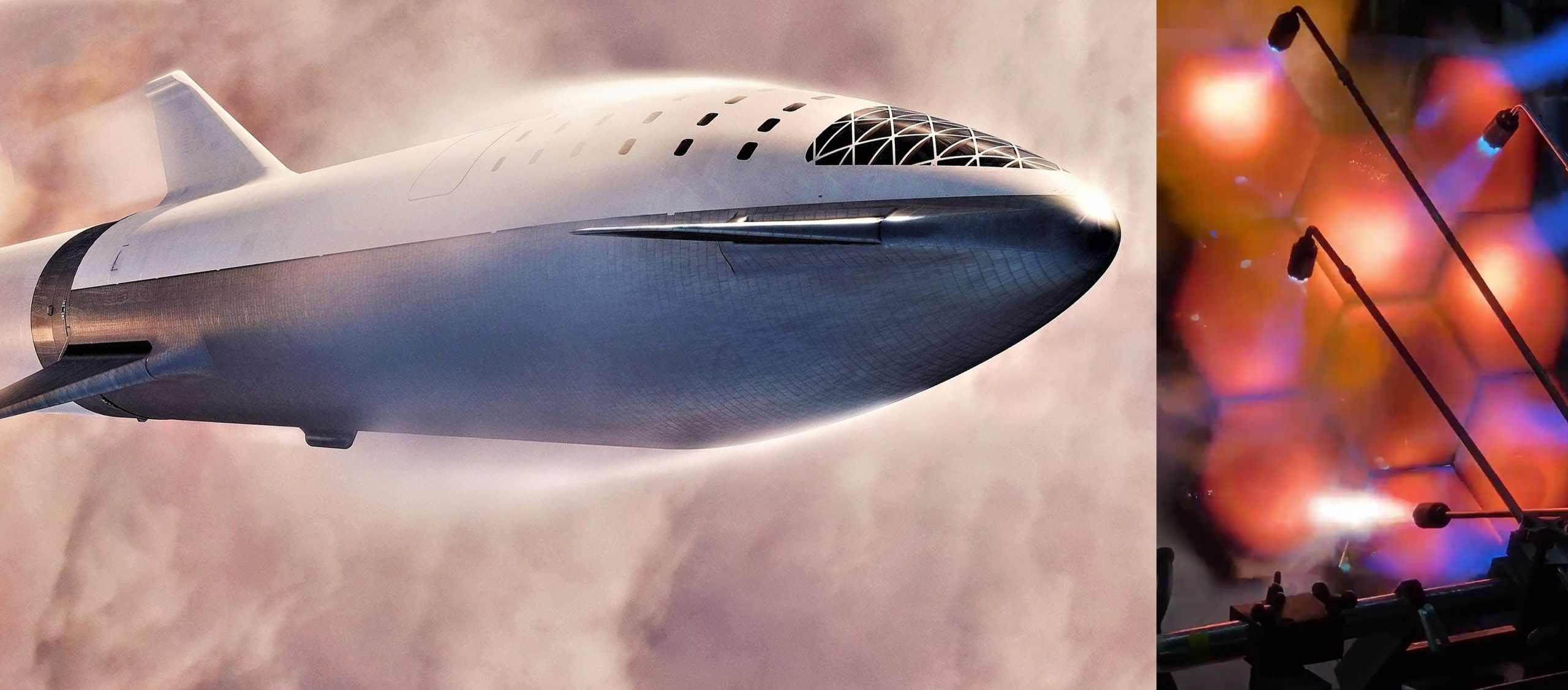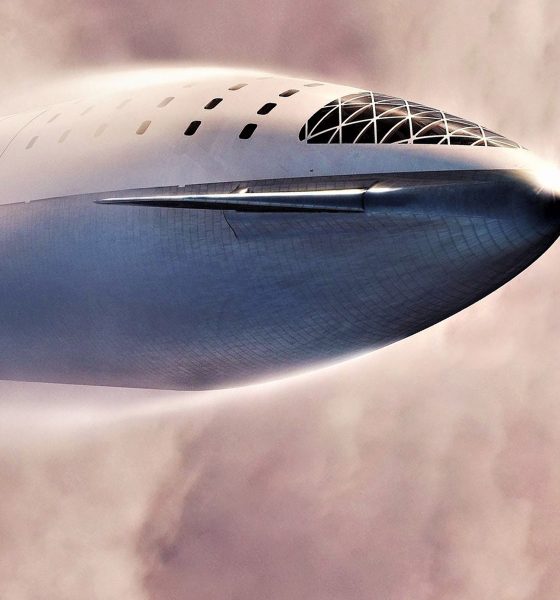

SpaceX
SpaceX’s first orbital Starship begins assembly as steel heat shield passes tests
SpaceX CEO Elon Musk says that the company’s South Texas workforce has already begun to fabricate the first orbital-class Starship prototype, while Hawthorne engineers and technicians are in the midst of performing small-scale testing of the vehicle’s unprecedented stainless steel heat shield.
To be assembled out of hexagonal tiles of (presumably) stainless steel, Starship’s metallic heat shield will be one of the most crucial aspects of the orbital spacecraft, particularly with respect to ensuring that it’s extraordinarily easy to reuse. To survive extreme interplanetary-velocity reentry conditions at Mars, Earth, and beyond and remain in a functional, flight-ready condition after landing, SpaceX will need to implement the world’s first orbital-class, large-scale metallic heat shield with an immature technology known as transpirational cooling.
By quite literally drilling tiny holes (pores) into heat shield plates at the hottest parts of Starship’s hull, transpirational cooling effectively allows a large portion of the heat of reentry to be wicked away by the flash evaporation of a liquid, typically water. For SpaceX’s Starship, it’s likely that the coolant of choice would be either liquid water or liquid methane, the former of which offers better cooling per unit of mass at the cost of added plumbing complexity and spaceship mass, while the latter would make use of the same propellant fueling the ship at the cost of worse cooling per unit of mass. Either way, SpaceX will be heading into unproven territory, demanding extensive ground and flight testing to first ensure that the concept is truly viable and then to verify that it can be made as reliable and reusable as it simply has to be.
Tests like those shown on March 17th by Musk indicate that SpaceX is indeed deep into the process of extensive and often destructive testing, something the company has proven to be exceptionally good at. It’s unclear if the above test of Starship’s hexagonal heat shield tiles – likely made out of a variant of 300-series stainless steel – involved tiles with active or passive cooling, but Musk suggested that the hot-spots created with spin-forming torches reached temperatures as high as 1650 Kelvin (2500ºF/1400ºC. Unlike the ablative heat shields SpaceX is familiar with building and operating through its Crew and Cargo Dragon spacecraft, a stainless steel heat shield would be expected to almost entirely resist erosion (i.e. ablation) during extremely high-velocity reentries of at least 12-14 km/s (~31,000 mph, Mach 40+).
Update on the fairing and the unknown “2nd fairing” pic.twitter.com/5PMBYyBDAi— Austin Barnard? (@austinbarnard45) March 16, 2019
Meanwhile, Musk also confirmed that SpaceX has decided to skip constructing a replacement nosecone/fairing for Starhopper, a functional Starship prototype that will be used to conduct extremely short hop tests like Falcon 9’s development-era Grasshopper and F9R test articles. Over the last several weeks, SpaceX technicians have been rapidly assembling what was initially assumed to be the replacement fairing Musk had previously suggested would be built. Instead, the duo of stainless steel barrel sections – relying on steel much thinner than the heavy-duty stuff used to build Starhopper – are apparently the beginnings of the first orbital-class Starship prototype, said by Musk to be aiming for flight-readiness as early as June 2019 around two months ago.
While still an extraordinarily ambitious target for a vehicle that has yet to conduct any integrated hops or flight-tests in any form, the fact that SpaceX is began the process of building the first orbital Starship in late February could actually give the company’s engineers and technicians a fighting chance to complete Starhopper testing and Starship assembly over the next 90-100 days.
If stacked atop each other, the two new steel sections in work would likely stretch a solid 20-30 meters (65-100 ft) tall. Meanwhile, the first orbital-grade tank domes and/or conical nose section is also in the process of being welded together out of smaller segments, already fast approaching something ready to be installed inside the steel barrel sections.
Check out Teslarati’s Marketplace! We offer Tesla accessories, including for the Tesla Cybertruck and Tesla Model 3.

News
SpaceX shades airline for seeking contract with Amazon’s Starlink rival

SpaceX employees, including its CEO Elon Musk, shaded American Airlines on social media this past weekend due to the company’s reported talks with Amazon’s Starlink rival, Leo.
Starlink has been adopted by several airlines, including United Airlines, Qatar Airways, Hawaiian Airlines, WestJet, Air France, airBaltic, and others. It has gained notoriety as an extremely solid, dependable, and reliable option for airline travel, as traditional options frequently cause users to lose connection to the internet.
Many airlines have made the switch, while others continue to mull the options available to them. American Airlines is one of them.
A report from Bloomberg indicates the airline is thinking of going with a Starlink rival owned by Amazon, called Leo. It was previously referred to as Project Kuiper.
American CEO Robert Isom said (via Bloomberg):
“While there’s Starlink, there are other low-Earth-orbit satellite opportunities that we can look at. We’re making sure that American is going to have what our customers need.”
Isom also said American has been in touch with Amazon about installing Leo on its aircraft, but he would not reveal the status of any discussions with the company.
The report caught the attention of Michael Nicolls, the Vice President of Starlink Engineering at SpaceX, who said:
“Only fly on airlines with good connectivity… and only one source of good connectivity at the moment…”
CEO Elon Musk replied to Nicolls by stating that American Airlines risks losing “a lot of customers if their connectivity solution fails.”
American Airlines will lose a lot of customers if their connectivity solution fails
— Elon Musk (@elonmusk) December 14, 2025
There are over 8,000 Starlink satellites in orbit currently, offering internet coverage in over 150 countries and territories globally. SpaceX expands its array of satellites nearly every week with launches from California and Florida, aiming to offer internet access to everyone across the globe.
Currently, the company is focusing on expanding into new markets, such as Africa and Asia.
News
Tesla hints at Starlink integration with recent patent
“By employing polymer blends, some examples enable RF transmission from all the modules to satellites and other communication devices both inside and outside the vehicle.”

Tesla hinted at a potential Starlink internet terminal integration within its vehicles in a recent patent, which describes a vehicle roof assembly with integrated radio frequency (RF) transparency.
The patent, which is Pub. No U.S. 2025/0368267 describes a new vehicle roof that is made of RF-transparent polymer materials, allowing and “facilitating clear communication with external devices and satellites.”
Tesla believes that a new vehicle roof design, comprised of different materials than the standard metallic or glass elements used in cars today, would allow the company to integrate modern vehicular technologies, “particularly those requiring radio frequency transmission and reception.
Tesla has recently filed a US patent application on integrating RF transparent materials into the roof structure.
“facilitating clear communication with external devices and satellites”
Tesla fleet is getting @Starlink connectivity integration soon. LFG @Tesla @elonmusk… pic.twitter.com/bLa8YtPLd1
— Chansoo Byeon (@Chansoo) December 9, 2025
Instead of glass or metallic materials, Tesla says vehicles may benefit from high-strength polymer blends, such as Polycarbonate, Acrylonitrile Butadiene Styrene, or Acrylonitrile Styrene Acrylate.
These materials still provide ideal strength metrics for crashworthiness, stiffness for noise, vibration, and harshness control, and are compliant with head impact regulations.
They would also enable better performance with modern technologies, like internet terminals, which need an uninterrupted signal to satellites for maximum reception. Tesla writes in the patent:
“By employing polymer blends, some examples enable RF transmission from all the modules to satellites and other communication devices both inside and outside the vehicle.”

One of the challenges Tesla seems to be aware of with this type of roof design is the fact that it will still have to enable safety and keep that at the forefront of the design. As you can see in the illustration above, Tesla plans to use four layers to increase safety and rigidity, while also combating noise and vibration.
It notes in the patent that disclosed examples still meet the safety requirements outlined in the Federal Motor Vehicle Safety Standards (FMVSS).
Starlink integrated directly into Tesla vehicles would be a considerable advantage for owners. It would come with a handful of distinct advantages.
Initially, the inclusion of Starlink would completely eliminate cellular dead zones, something that is an issue, especially in rural areas. Starlink would provide connectivity in these remote regions and would ensure uninterrupted service during road trips and off-grid adventures.
It could also be a critical addition for Robotaxi, as it is crucial to have solid and reliable connectivity for remote monitoring and fleet management.
Starlink’s growing constellation, thanks to SpaceX’s routine and frequent launch schedule, will provide secure, stable, and reliable internet connectivity for Tesla vehicles.
Although many owners have already mounted Starlink Mini dishes under their glass roofs for a similar experience, it may be integrated directly into Teslas in the coming years, either as an upgrade or a standard feature.
Investor's Corner
SpaceX IPO is coming, CEO Elon Musk confirms
However, it appears Musk is ready for SpaceX to go public, as Ars Technica Senior Space Editor Eric Berger wrote an op-ed that indicated he thought SpaceX would go public soon. Musk replied, basically confirming it.

Elon Musk confirmed through a post on X that a SpaceX initial public offering (IPO) is on the way after hinting at it several times earlier this year.
It also comes one day after Bloomberg reported that SpaceX was aiming for a valuation of $1.5 trillion, adding that it wanted to raise $30 billion.
Musk has been transparent for most of the year that he wanted to try to figure out a way to get Tesla shareholders to invest in SpaceX, giving them access to the stock.
He has also recognized the issues of having a public stock, like litigation exposure, quarterly reporting pressures, and other inconveniences.
However, it appears Musk is ready for SpaceX to go public, as Ars Technica Senior Space Editor Eric Berger wrote an op-ed that indicated he thought SpaceX would go public soon.
Musk replied, basically confirming it:
As usual, Eric is accurate
— Elon Musk (@elonmusk) December 10, 2025
Berger believes the IPO would help support the need for $30 billion or more in capital needed to fund AI integration projects, such as space-based data centers and lunar satellite factories. Musk confirmed recently that SpaceX “will be doing” data centers in orbit.
AI appears to be a “key part” of SpaceX getting to Musk, Berger also wrote. When writing about whether or not Optimus is a viable project and product for the company, he says that none of that matters. Musk thinks it is, and that’s all that matters.
It seems like Musk has certainly mulled something this big for a very long time, and the idea of taking SpaceX public is not just likely; it is necessary for the company to get to Mars.
The details of when SpaceX will finally hit that public status are not known. Many of the reports that came out over the past few days indicate it would happen in 2026, so sooner rather than later.
But there are a lot of things on Musk’s plate early next year, especially with Cybercab production, the potential launch of Unsupervised Full Self-Driving, and the Roadster unveiling, all planned for Q1.








